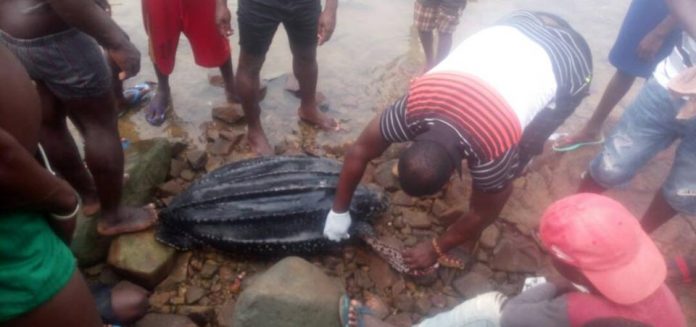Sea turtles are frequently caught by local fisherman in Ghana and it’s young Ghanaian conservationist Eric Quayson’s job to work with those fisherman to make sure that as many turtles as possible make their way back to sea, after being tagged.
In Quayson’s hometown is Axim, a port of around 28,000 people in south-west Ghana, the big industry is fishing. He says that his sea turtles started in 2012, when he met John Flynn, founder of marine conservation NGO Wildseas, came to Axim to talk to the head fisherman there about sharks.
Quayson was able to help Flynn out and soon enough he offered Quayson the opportunity to work with Wildseas – and find some way to get the fishermen to free the turtles they catch.
“At the time I was doing general work around my community and helping my family on their fishing business most days, but this chance meeting brought me to where I am now,” he said, “My work is to save lives and try to protect sea turtles. They are an important part of the ocean and each species has its part to do in keeping the oceans healthy.”Today In: Innovation
Quayson says that for generations fisherman in Axim also caught turtles, including the vulnerable Leatherback Turtle, to eat them or sell them, but that is slowly changing.
“Many projects I have seen do public awareness and education focus on school and protecting beaches where turtles nest but I hadn’t seen any project doing what I am doing,” he said, “I think that is the very important to involve and respect the fishermen and the part they can help in protecting turtles.
I think that my project is special because it includes the fishermen as a big part of a conservation solution.Eric Quayson, Wildseas
Quayson is in charge of tagging in Axim and four other towns.
“When the fisherman give us the turtle we take species size sex and then metal flipper tag the turtle, “ he said, adding that the data is then added to the Cooperative Marine Turtle Tagging Program.
According to Quayson, another big opportunity in conservation is to get the fishermen to want to release the turtles not because of law but because they understand why turtles are important.
“When I tell a fisherman what a Leatherback turtle does in the ecosystem, the fisherman understand that its better to keep the Leatherback in the sea because there will be more fish for them to catch – it eats jellyfish and jellyfish eat fish eggs,” he said, “Over 1700 turtles have been saved by working with the fishermen and I think I have probably been directly involved in maybe 1000 of those releases,” he said.

Quayson is now taking the success of his program to other countries in the region.
“In 2019, I went to The Gambia to work with local NGO called Smile For Life and introduce fishermen program, he said, “My work with the fishermen is something that can be done in any place where fishermen catch turtles but it does not happen in many places.”
Quayson isn’t the only local scientist working to study and conserve turtle species in Sub-Saharan Africa. In November 2019, Tomas Diagne a turtle biologist from Senegal received a big surprise in a theater in London – he had just won the 2019 Tusk Award for Conservation in Africa, presented by Prince William.
RELATED: How Did This Senegalese Scientist Meet Prince William? Turtles!
Diagne says the £20,000 ($US 26,000) prize will go towards African Chelonian Institute, which he founded and is a learning and research center for various turtle species in West Africa.
RELATED: How Do You Map Africa’s Mischievous Manatees?
His wife, Lucy Keith-Diagne is a scientist working on the African Manatee and she is also the founder and director of the African Aquatic Conservation Fund.
Forbes.com

Putting a spotlight on business, inventions, leadership, influencers, women, technology, and lifestyle. We inspire, educate, celebrate success and reward resilience.















